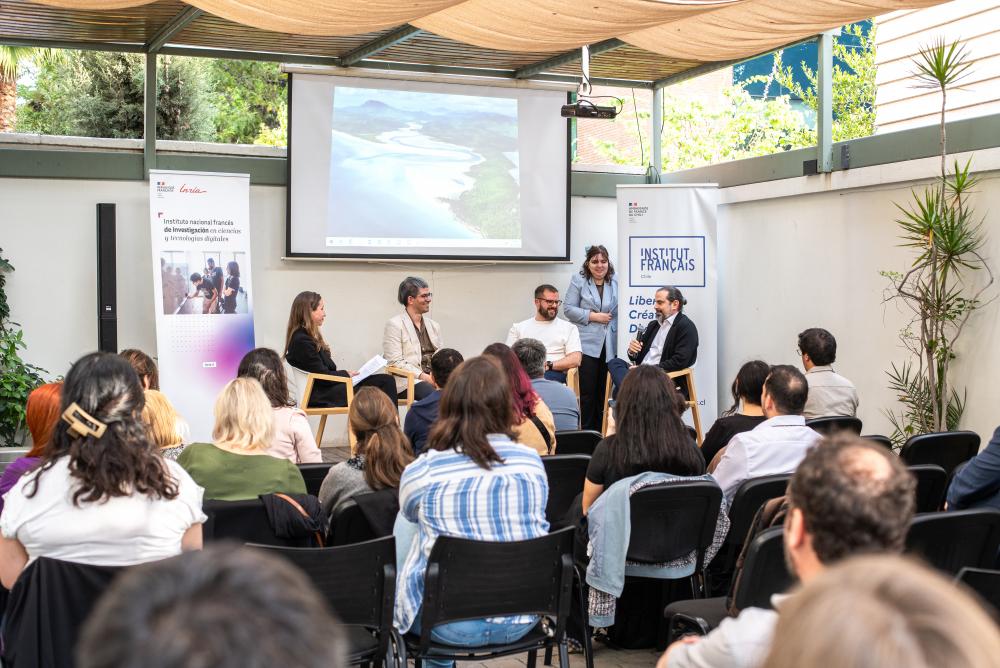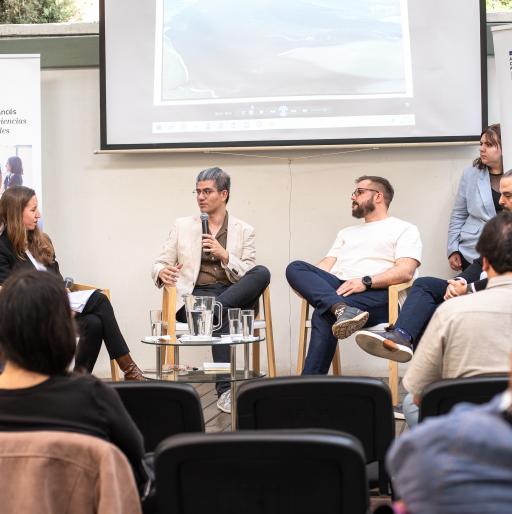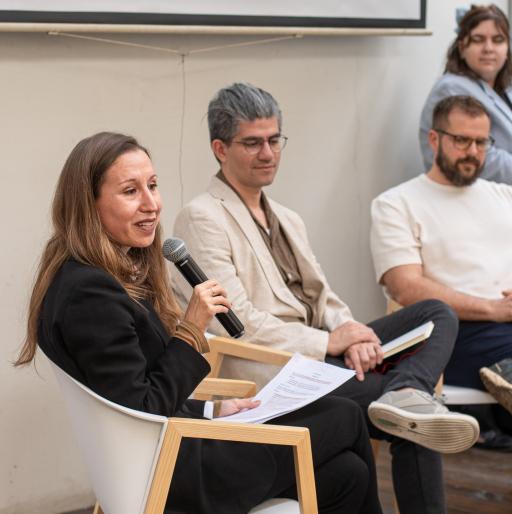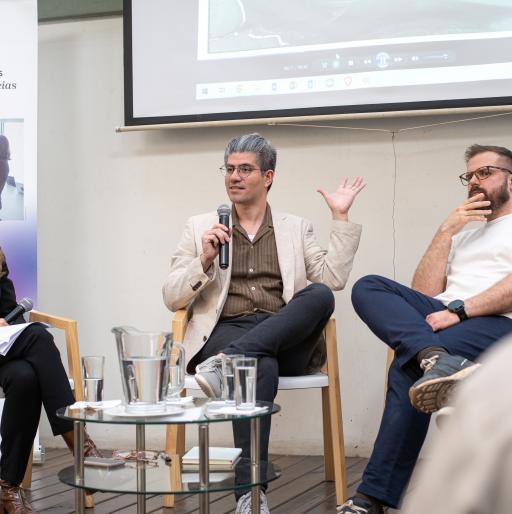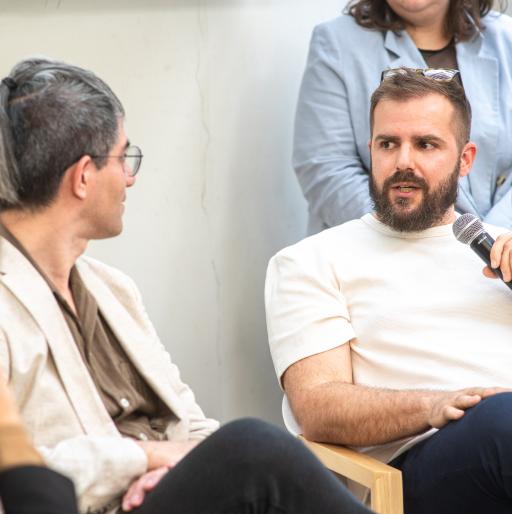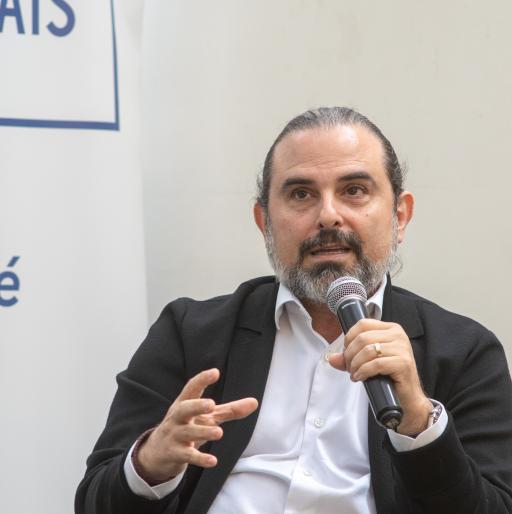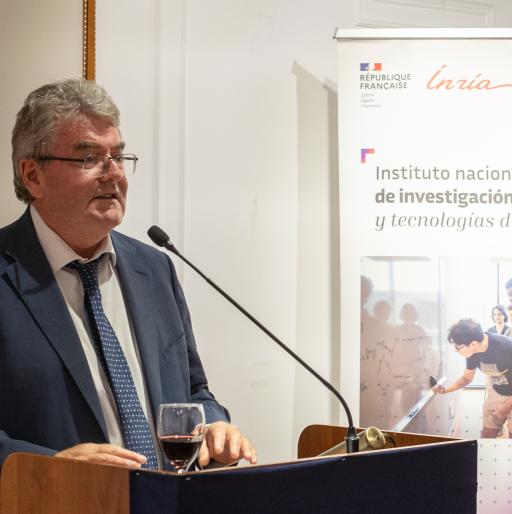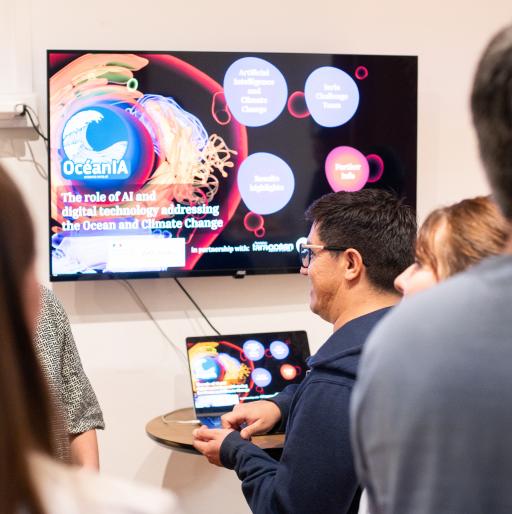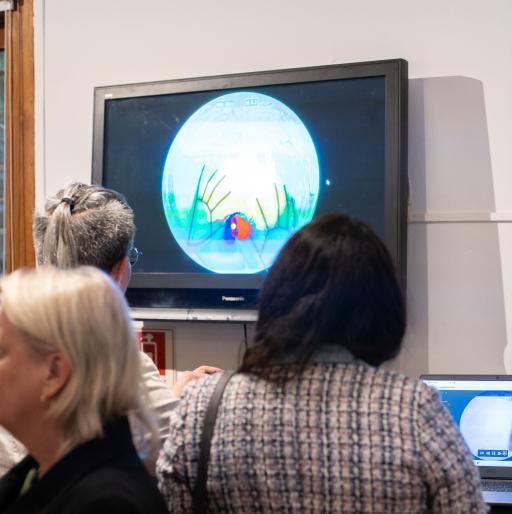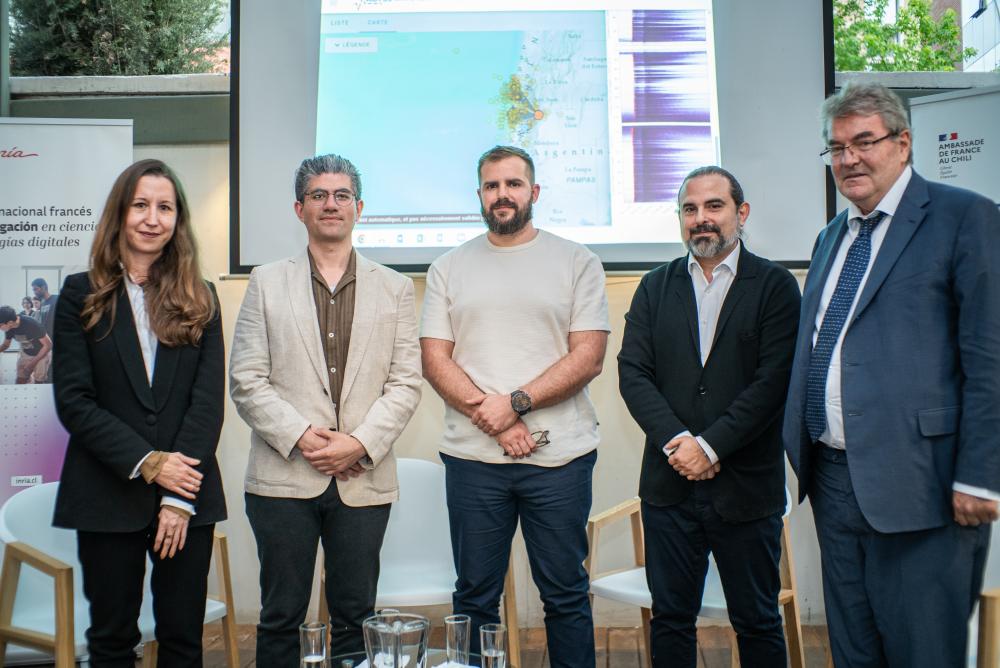As has become tradition, Inria Chile set out to bring science closer to children and young people in a new edition of the Fête de la Science, organised in the country by the Institut Français du Chili and the Agence pour l’Enseignement Français à l’Étranger (AEFE) network. During a week rich in knowledge and science, the Vitacura and Chamisero campuses of the Lycée Antoine de Saint-Exupéry hosted researchers from Inria Chile, who shared their projects through talks and interactive workshops. The programme included the presentation of the AirWARD platform for early detection of wildfires, a robotics workshop with Poppy Ergo Jr., and talks on how artificial intelligence helps us to understand the oceans ever better through the OcéanIA project.
The week also featured a closing event organised by Inria Chile and the Institut Français de Chile. The round table, “How can artificial intelligence help us face natural hazards?”, brought together José Galaz, researcher at CIGIDEN, Luis Martí, Scientific Director of Inria Chile, and Bertrand Potin, seismologist at the Seismic Risk Programme (PRS) of the Universidad de Chile.
Verbatim
The Fête de la Science, led by France’s Ministry of Higher Education and Research, is a landmark event celebrated around the world and, for France and Chile, it symbolises our shared commitment to a culture of science. It is a week in which curiosity becomes knowledge, and in which our collaborative research ties are reaffirmed. At Inria Chile, our role in this initiative is crucial: to connect the digital with tangible social impact. Over our 13 years in the country, we have worked tirelessly to ensure that our high-tech solutions — in artificial intelligence, data and modelling — translate into direct benefits for society. The Fête de la Science is the perfect stage to demonstrate this. Seeing young people discover robotics, learn how artificial intelligence helps to detect wildfires or to understand the oceans, or to understand the universe, among many others, is the materialisation of our goal. We need to captivate the youngest and show them that the digital sciences are not abstract but a powerful and playful tool to solve tomorrow’s great challenges. If we can spark that sense of wonder, we will have secured a new generation of scientists capable of innovating and generating impact. That is our mission and our greatest motivation.
Director of Inria Chile / Director of the Franco-Chilean Binational Center on Artificial Intelligence
“Intelligence (s)” in the classroom: workshops and talks at the Lycée
Over an intensive week, the Vitacura and Chamisero campuses of the Lycée Antoine de Saint-Exupéry welcomed researchers from Inria Chile, who shared some of their projects with pupils through talks and interactive workshops. The aim was to spark curiosity and to show, in simple language and with concrete examples, how artificial intelligence helps to deliver digital solutions to real-world problems.
The programme connected theory and practice with activities showcasing concrete applications of artificial intelligence. Rayner de Ruyt, a researcher at Inria Chile, presented the AirWARD platform, a system that uses artificial intelligence for the early warning of wildfires. In his talk, pupils learned how artificial intelligence and technology are applied to address a critical problem, through a real, high-impact social use case.
In the educational robotics workshop “Learning to programme a robot”, engineers Rayner de Ruyt and Raúl Rippe guided pupils in an interactive activity with Poppy Ergo Jr. Pupils were able to learn how it is programmed and to control the robotic arm directly. The arm is part of an Inria open-source project that makes learning programming and robotics practical and engaging.
Researcher Luis Valenzuela explained in the talk “Oceans and climate change through artificial intelligence and genomics” how these tools help to understand the ocean’s role in the climate, sharing results obtained within Inria Chile’s OcéanIA project.
For his part, Alan Contreras explained how convolutional neural networks work and explored their diverse applications in areas such as health and astronomy. The activity included a real-time demonstration of image classifiers to show, in practical terms, how this technology operates.
In the workshop “The power of working together”, Matías Neto led a playful activity designed for primary-school pupils. The workshop invited children to observe birds in action and then, working in teams, to build a prototype nest — teaching the importance of cooperation and teamwork for scientific and technological projects.
Meanwhile, Paul Escapil-Inchauspé spoke about applications of engineering in artificial intelligence. From idea to prototype in artificial-intelligence systems, he set out design criteria, robustness and evaluation — principles that connect research and applications to solve complex problems with a responsible approach.
For Carole Alvarez, a Mathematics teacher at the Lycée Antoine de Saint-Exupéry, these activities are essential to show pupils at different levels that their education goes beyond theory. She explained that the aim is to connect their skills with the country’s challenges:
“The importance of these talks is that pupils should see things dynamically and understand that it is not just calculation, not only exercises — there is a practical way to implement, there is something behind it. We want to show them that there is a future with application, with real things that can change issues in the country and solve problems. In this way, they can realise that with their skills they are capable of achieving something in the future to change the dilemmas the country faces.”
A high-impact close: AI and natural hazards
Inria Chile’s activities during this edition of the Fête de la Science culminated with the closing event organised by Inria Chile and the Institut Français in the courtyard of the Institute. Under the question “How can artificial intelligence help us face natural hazards?”, the evening brought together experts and the general public in a vital dialogue for a country like Chile.
The conversation featured a multidisciplinary round table that addressed the topic from different perspectives, demonstrating the need for collaboration to meet complex challenges. The panel comprised:
-
José Galaz, Postdoctoral Researcher at the Research Centre for Integrated Disaster Risk Management (CIGIDEN) and creator of TsunamiLab
-
Luis Martí, Scientific Director of Inria Chile and specialist in artificial intelligence
-
Bertrand Potin, Seismologist at the Seismic Risk Programme (PRS), University of Chile
-
Eve Vaiarelli, Attachée for Scientific and University Cooperation at the Embassy of France in Chile, panel moderator
In his remarks, Luis Martí explained that, beyond the concerns it can raise, artificial intelligence can be understood as the transfer of human capabilities to a computer, enabling tasks to be carried out much faster and at large scale. He underlined that its main strength lies in the ability to process huge volumes of data and detect subtle patterns that would be imperceptible to a person:
“Artificial intelligence is already an inseparable tool for almost any human activity we can do. In the case of natural disasters, it has the ability to see or extract knowledge from very subtle information that is hard to distinguish with the human eye; so we can do everything from trying to predict earthquakes to preventing wildfires with satellite imagery, creating predictors for many things, as long as we have data.”
Asked how to make complex scientific tools accessible to the public and to decision-makers, José Galaz emphasised the need to broaden the view beyond environmental impact and to recognise the human component. He highlighted that the first step is for the scientific community itself to embrace the importance of communicating knowledge and building ties with society:
“The key ingredient lies in understanding and creating new ties and collaborations with public and private institutes and with local communities, understanding that risk is not only natural. When we talk about risk we should in fact say socionatural risk and consider all the human dimensions, and also the social, political and urban planning aspects that go with it.”
For his part, Bertrand Potin outlined the main challenge facing his discipline: the inability to process the enormous volume of seismic data generated. He explained that, because of this limitation, only higher-magnitude earthquakes are currently analysed manually, leaving aside micro-earthquakes that are essential for understanding the behaviour of dangerous faults such as San Ramón:
“In Chile only earthquakes of magnitude 2.8 or higher are processed and, in truth, because of this limitation we cannot process more information. Yet the small ones are of great interest because they give us information about fault geometry. One might say small magnitudes do not matter, they are micro-earthquakes, we are not interested. If we do not look at magnitude 1 and 2 events, we will not see the seismicity of this fault’s activity (San Ramón). Looking at this kind of low seismicity gives us information about the fault’s geometry and, based on that, we can predict its capacity to generate certain types of earthquake. Artificial intelligence here will allow us to process those data that we do not currently know how to process.”
After the discussion, attendees explored a demonstration showcase with concrete Inria Chile projects that apply these technologies. One highlight was the TsunamiLab tsunami simulator, an interactive tool that calculates, in real time, both hypothetical and historical scenarios, enabling the visualisation of wave propagation anywhere in the world using only a web browser.
The initiatives FrostForecast, a system for predicting anomalous weather conditions at micro-plot level that enables farmers and agricultural technology providers to focus their efforts and reduce production losses due to frosts, and Vendimia 5.0, a digital system integrated by predictive models based on artificial intelligence that makes it possible to forecast harvest volume, vine phenology, grape-ripeness tracking, and the scheduling of grape reception and oenological operations, are targeted at extreme climate phenomena in agriculture.
The OcéanIA artificial-intelligence toolbox was also presented. It is a pioneering project dedicated to unravelling the complexities of the global oceanic symbiont through state-of-the-art artificial intelligence and mathematical modelling, leveraging vast data sets and advanced computational techniques, and transforming our understanding of ocean ecosystems, climate change and marine biodiversity.
Patrick Flot, Counsellor for Cooperation and Cultural Action at the Embassy of France in Chile and Director of the Institut Français, underlined how the emergence of artificial intelligence has reinforced and further structured the solid cooperation between France and Chile, and highlighted Inria Chile as an essential actor for Franco-Chilean cooperation in this field.
Verbatim
The purpose of the Fête de la Science is to connect the scientific world with new generations, showing that science is at the service of citizens. We want schools and pupils to take an interest through mediation by researchers and by French and Chilean institutions that work every day in Chile on the numerous topics that science enables us to address here. France and Chile maintain a long-standing and rich collaboration between research centres in both nations; this is one of the pillars of our scientific and university cooperation between our countries.
Director of the Institut Français / Patrick Flot Counsellor for Cooperation and Cultural Action, Embassy of France in Chile Director of the Institut Français

